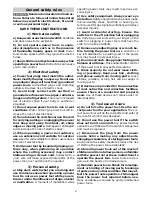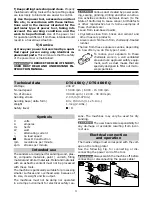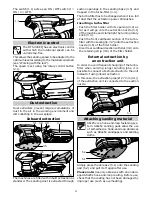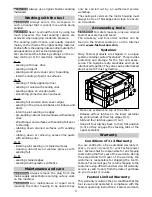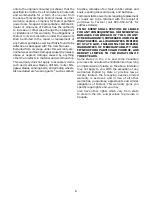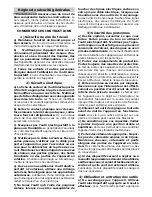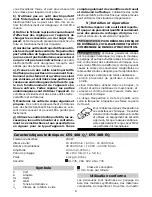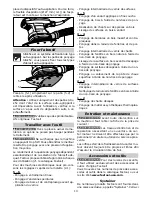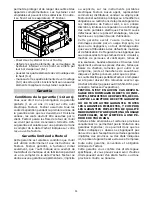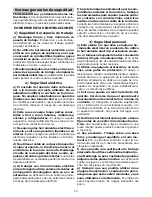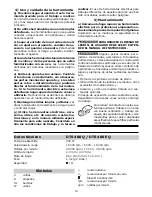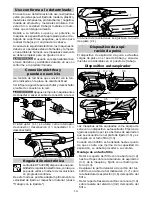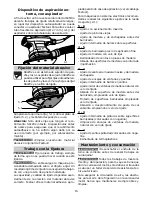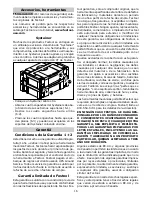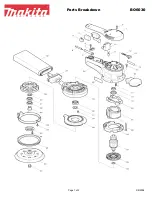
2
General safety rules
Read and understand all instruc-
tions. Failure to follow all instructions listed
below may result in electric shock, fi re and/
or serious personal injury.
SAVE THESE INSTRUCTIONS
1) Work area safety
a) Keep work area clean and well lit.
Cluttered
and dark areas invite accidents.
b) Do not operate power tools in explo-
sive atmospheres, such as in the presence
of fl ammable liquids, gases or dust.
Power
tools create sparks which may ignite the dust or
fumes.
c) Keep children and bystanders away while
operating a power tool.
Distractions can cause
you to lose control.
2) Electrical safety
a) Power tool plugs must match the outlet.
Never modify the plug in any way. Do not use
any adapter plugs with earthed (grounded)
power tools.
Unmodifi ed plugs and matching
outlets will reduce risk of electric shock.
b) Avoid body contact with earthed or
grounded surfaces such as pipes, radiators,
ranges and refrigerators.
There is an increased
risk of electric shock if your body is earthed or
grounded.
c) Do not expose power tools to rain or wet
conditions.
Water entering a power tool will in-
crease the risk of electric shock.
d) Do not abuse the cord. Never use the cord
for carrying, pulling or unplugging the power
tool. Keep cord away from heat, oil, sharp
edges or moving parts.
Damaged or entangled
cords increase the risk of electric shock.
e) When operating a power tool outdoors,
use an extension cord suitable for outdoor
use.
Use of a cord suitable for outdoor use reduces
the risk of electric shock.
f) Hold power tool by insulated gripping sur-
faces only, when performing an operation
where the cutting accessory may contact
hidden wiring or its own cord.
Contact with a
„live“ wire will make exposed metal parts of the
power tool „live“ and shock the operator.
3) Personal safety
a) Stay alert, watch what you are doing and
use common sense when operating a power
tool. Do not use a power tool while you are
tired or under the infl uence of drugs, alcohol
or medication.
A moment of inattention while
operating power tools may result in serious per-
sonal injury.
b) Use safety equipment. Always wear eye
protection.
Safety equipment such as dust mask,
non-skid safety shoes, hard hat, or hearing pro-
tection used for appropriate conditions will reduce
personal injuries.
c) Avoid accidental starting. Ensure the
switch is in the off position before plugging
in.
Carrying power tools with your fi nger on the
switch or plugging in power tools that have the
switch on invites accidents.
d) Remove any adjusting key or wrench be-
fore turning the power tool on.
A wrench or a
key left attached to a rotating part of the power
tool may result in personal injury.
e) Do not overreach. Keep proper footing and
balance at all times.
This enables better control
of the power tool in unexpected situations.
f) Dress properly. Do not wear loose cloth-
ing or jewellery. Keep your hair, clothing
and gloves away from moving parts.
Loose
clothes, jewellery or long hair can be caught in
moving parts.
g) If devices are provided for the connection
of dust extraction and collection facilities,
ensure these are connected and properly
used.
Use of these devices can reduce dust re-
lated hazards.
4) Tool use and care
a) Do not force the power tool. Use the cor-
rect power tool for your application.
The cor-
rect power tool will do the job better and safer at
the rate for which it was designed.
b) Do not use the power tool if the switch
does not turn it on and off.
Any power tool that
cannot be controlled with the switch is dangerous
and must be repaired.
c) Disconnect the plug from the power
source before making any adjustments,
changing accessories, or storing power tools.
Such preventive safety measures reduce the risk
of starting the power tool accidentally.
d) Store idle power tools out of the reach of
children and do not allow persons unfamiliar
with the power tool or these instructions to
operate the power tool.
Power tools are dan-
gerous in the hands of untrained users.
e) Maintain power tools. Check for misalign-
ment or binding of moving parts, breakage
of parts and any other condition that may af-
fect the power tools operation. If damaged,
have the power tool repaired before use.
Many accidents are caused by poorly maintained
power tools.


